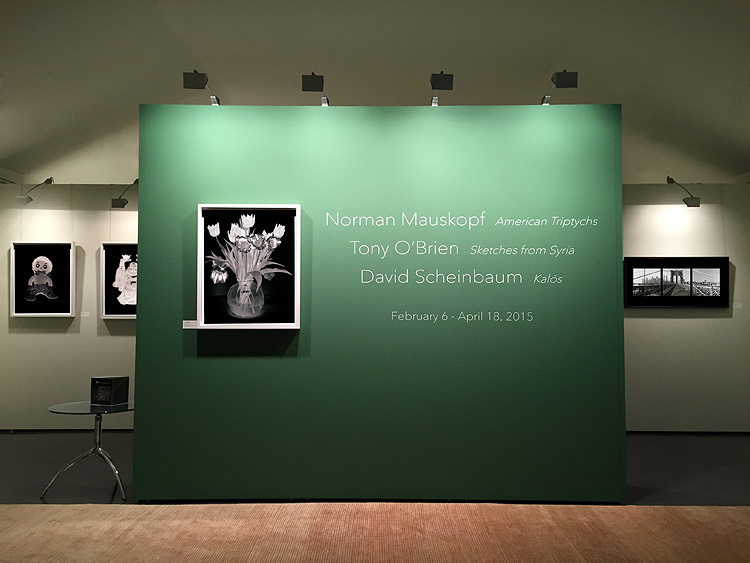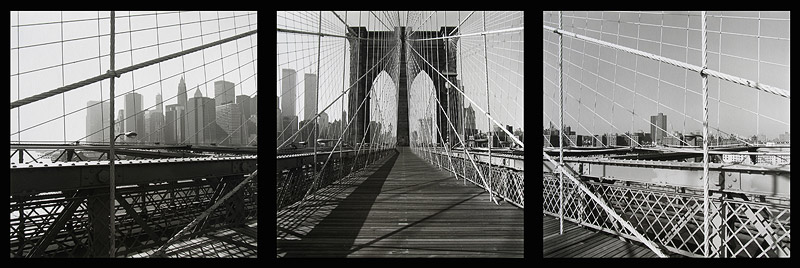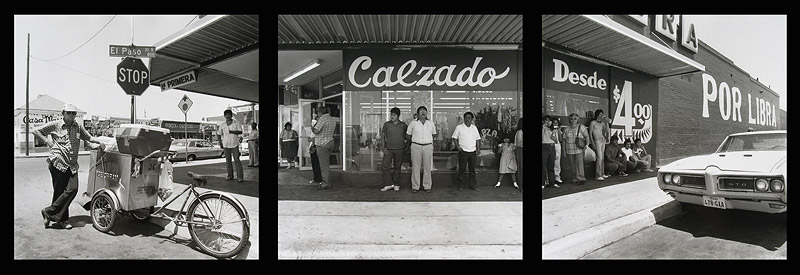
© Verve gallery
Expositions du 6/2/2015 au 18/4/2015 Terminé
VERVE Gallery of Photography 219 East Marcy Street New Mexico 87501 Santa Fe États-Unis
For a decade, from 1981 to 1991, Norman Mauskopf traveled throughout the United States working on this special photo project, American Triptychs. He searched carefully for man-made environments that exemplified certain unique facets of late-20th-century Americana. Most were on a large panoramic scale, and their subject matter was often quirky or mysterious.VERVE Gallery of Photography 219 East Marcy Street New Mexico 87501 Santa Fe États-Unis
.jpg)
© Norman Mauskopf - Cabazon, California, 1984
Norman sought to capture these scenes with a feeling of depth and detail. Had he used a panoramic camera, it would have given him a wide perspective that would have exaggerated the foreground, while at the same time pushing the middle ground and background farther away. However, he wanted his triptychs to give him equal horizontal and vertical perspectives in a single frame. Thus, Norman chose to use a square-format camera with a slightly wider-than-normal focal length. He placed the camera on a tripod and created the panorama in three separate frames, creating a triptych. The placement of the tripod was critical because each frame had to have its own compositional qualities, stand alone as an image, and still be connected to the adjacent frame at an appropriate juncture in the panoramic scene. Sometimes, because of the way the lens rendered diagonal lines, the juncture of two frames resulted in a slight kink in perspective that adds to the unconventional nature of the image. A close examination of Norman's triptychs reveals that he indeed captures scenes with depth and detail. Perhaps one of the best examples of his work is his image of the Brooklyn Bridge, entitled New York, New York, 1985. The middle ground and background are not pushed farther away, as would have been the case with a panoramic camera. Moreover, each separate image in the composition has exceptional detail.
.jpg)
© Norman Mauskopf - Arthur, Walla Walla, Washington 1984
The corner shot, El Paso, Texas, 1985, similarly is the essence of explicit detail and composition : The image of the ice cream vendor under the stop sign at the corner of 800 El Paso Street is sharp in detail and compositionally stands on its own. The shadow line in all three images aligns perfectly. And, finally, in the right image one can easily make out the detail of the Texas license plate on the Pontiac GTO, and the depth of field extends the full length of the image.

© Norman Mauskopf - New York, New York, 1985
Two of Norman's images foretell the passage of time, and both are iconic symbols strange, unconventional, idiosyncratic captured moments now lost or soon to be lost to the past. One is of Arthur and his cigarettes in Arthur, McFeely Tavern, Walla, Washington, 1984; his cigarettes have gone up in smoke. Second, Norman's pièce de résistance, where his dry wit comes to life in his visual metaphor of the future, is entitled Cabazon, California, 1984. In this triptych he juxtaposes a scale model of a massive Cretaceous Period herbivore and the source of our fossil fuels, an Alamosaurus sanjuanensis, with an 18-wheeler petrol tank truck, Truckuspetrolsurus de minimis.

© Norman Mauskopf - El Paso, Texas, 1985
During a distinguished 30-year photography career, Norman Mauskopf has had four award-winning books of his photographs published by Twin Palms/Twelvetrees Press, and he has been the recipient of a W. Eugene Smith Fellowship. His most recent book, Descendants, published in 2011, is a pictorial exploration of Latino culture of northern New Mexico's its ancient traditions, striking landscapes and ethnic diversity. A Time Not Here, published in 1997, focuses on African-American musical and spiritual traditions in Mississippi and was described as "a focused documentary of astonishing beauty." His second book, Dark Horses, published in 1988, documents the world of thoroughbred horseracing and was described as "classic photojournalism slyly refracted through prisms of drama, majesty and humor." Norman's first book, Rodeo, published in 1985, looks into the lives of professional rodeo cowboys. About the images in Rodeo, author Ben Maddow wrote, "They are not merely photographs but observations deeply seen and deeply felt. . . . Norman has uncovered something profound and instinctive." Norman has also completed a rare documentary on the legal brothels of Mustang, Nevada.

